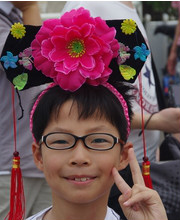| 图片: | |
|---|---|
| 名称: | |
| 描述: | |
- B1721又一例胃黏膜病变, 请高诊 ( 已确诊: 胃黏膜下丛状纤维粘液瘤 )
| 性别 | 女 | 年龄 | 51 | 临床诊断 | 胃癌 |
|---|---|---|---|---|---|
| 一般病史 | 胃部不适 | ||||
| 标本名称 | 部分胃壁 | ||||
| 大体所见 | 部分胃壁组织,S 5x3.5cm,粘膜表面见一息肉状肿物直径约2.5cm,粘膜下见结节状肿物直径约2cm,切面灰红,质软,边界不清。 | ||||
-
本帖最后由 海上明月 于 2013-09-10 09:58:45 编辑

- 博学之,审问之,慎思之,明辨之,笃行之。
相关帖子
丛状纤维粘液瘤/丛状血管粘液样肌纤维母细胞性肿瘤,这个肿瘤就是因为组织学特征表现为瘤细胞少至中等量的多灶微结节在胃壁内丛状生长。本例粘液很少,免疫组化DESMIN+,与最初报道不付。相信这类肿瘤有总一个范围,(如同粘液稀少的MTSCC,记得明月老师上传过一例)。DES在有些报道中部分病例部分+,我们还需要对其进一步认识。
本例考虑符合丛状纤维粘液瘤。
本例丛状结构、粘液样背景、梭形细胞,免疫组化也支持,符合胃丛状纤维粘液瘤。
胃丛状纤维黏液瘤(Plexiform Fibromyxoma,PFM)是第4版WHO消化道系统肿瘤(2010年)新增添的胃间叶性肿瘤类型,非常罕见,特征性地发生于胃,常位于胃窦部和幽门,可蔓延至十二指肠球部。肿瘤直径大小3cm至15cm(中位直径5.5cm)。组织学特征性地表现为瘤细胞少至中等量的多灶微结节在胃壁内丛状生长,结节内还包括胶原、粘液样和纤维粘液样肿瘤成分。丛状毛细血管结构有时很显著。浸润至胃外(包括浆膜下结节)的瘤组织中,梭形瘤细胞有时更丰富,呈实性非丛状生长。瘤细胞椭圆至梭形,不典型性不明显,核分裂像<5/50个HPF。溃疡、粘膜浸润和血管侵犯常见,但这些与预后无关。因为目前已发现的病例预后好,无复发倾向。免疫组化,瘤细胞表达α-SMA,还表达CD10,一致不表达KIT、DOG1、CD34、desmin和S-100蛋白。应与黏液型GIST、神经鞘膜肿瘤和其他纤维粘液样肿瘤相鉴别。
本例病变有两个:1 为突起于粘膜表面的息肉样肿物,可见平滑肌束呈树枝状长入息肉中,所以,首先考虑P-J息肉;2 为粘膜下间叶源性梭形细胞肿瘤,首先考虑胃肠道间质瘤(GIST),如果是GIST(尚需要除外平滑肌瘤、神经鞘瘤等),需要排除是否为琥珀酸脱氢酶缺陷型GIST(SDH-dificient GIST),此型GIST为2013版WHO软组织肿瘤新加类型,多结节生长,细胞呈上皮样,好发于胃,常淋巴结转移,核分裂不能评估其生物学行为,可做免疫组化SDHB证实。不过此例瘤细胞上皮样表现不明显,但是也需警惕。
所以此例需要免疫组化确诊粘膜下间叶源性梭形细胞肿瘤的性质:CD34,CD117,DOG-1,S-100,SMA.

- 苦心人天不负,卧薪尝胆,三千越甲可吞吴
Plexiform fibromyxoma: a distinctive benign gastric antral neoplasm not to be confused with a myxoid GIST.
Source
Department of Soft Tissue Pathology, Armed Forces Institute of Pathology, Washington, DC 20306-6000, USA. miettinen@afip.osd.mil
Abstract
A great majority of gastric mesenchymal tumors are gastrointestinal stromal tumor (GIST). A rare group of non-GISTs include myxoid mesenchymal neoplasms. In this report, we describe 12 cases of a distinctive gastric tumor, named here as plexiform fibromyxoma. These tumors occurred in 5 men and 7 women of ages 7 to 75 years (median, 41 y). All tumors were located in the gastric antrum and 6 of them also extended into extragastric soft tissues or into the duodenal bulb. The tumors measured from 3 to 15 cm (median, 5.5 cm). Histologically typical was a plexiform intramural growth with multiple micronodules containing paucicellular to moderately cellular myxoid to collagenous and fibromyxoid neoplastic elements. A prominent, sometimes plexiform capillary pattern was typically present. Extramural components included subserosal nodules, and sometimes more cellular, solid nonplexiform spindle cell proliferation. The tumor cells varied from oval to spindled and had limited atypia and mitotic activity < 5/50 high-power fields. Frequent ulceration, mucosal invasion, and vascular invasion (4 cases) had no adverse significance in these tumors. Immunohistochemically, the tumor cells were positive for alpha smooth muscle actin, and variably for CD10, and were consistently negative for KIT, DOG1, CD34, desmin, and S100 protein. No KIT or platelet-derived growth factor receptor alpha mutations were present in the 3 examined cases. None of the 4 patients who were followed from 9 to 20 years (median, 19 y) developed recurrences or metastases. Additional 3 patients survived 14 to 25 years with unknown tumor status. Review of large numbers of mesenchymal tumors in the esophagus and intestines did not reveal similar tumors. Plexiform fibromyxoma is a distinctive benign gastric antral neoplasm that should be separated from GIST, nerve sheath tumors, and other fibromyxoid neoplasms.

- 王军臣
-
zyyzwangjin 离线
- 帖子:1220
- 粉蓝豆:262
- 经验:1873
- 注册时间:2013-08-19
- 加关注 | 发消息





































